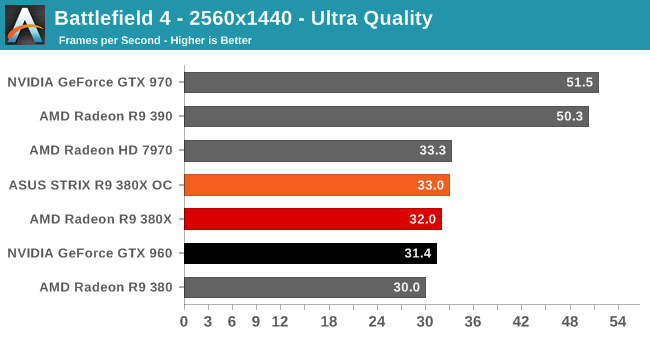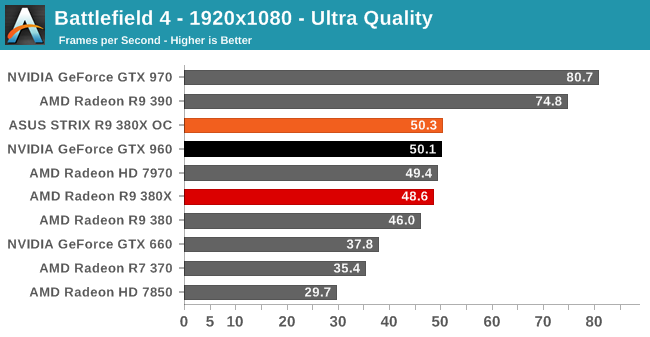The AMD Radeon R9 380X Review, Feat. ASUS STRIX
by Ryan Smith on November 23, 2015 8:30 AM EST- Posted in
- GPUs
- AMD
- Radeon
- Asus
- Radeon 300
Battlefield 4
Kicking off our benchmark suite is Battlefield 4, DICE’s 2013 multiplayer military shooter. After a rocky start, Battlefield 4 has since become a challenging game in its own right and a showcase title for low-level graphics APIs. As these benchmarks are from single player mode, based on our experiences our rule of thumb here is that multiplayer framerates will dip to half our single player framerates, which means a card needs to be able to average at least 60fps if it’s to be able to hold up in multiplayer.


Though not doing poorly, Battlefield 4 has not been a game AMD’s products have excelled at lately. Case in point, at 1080p even the referenced clocked R9 380X can’t unseat the GeForce GTX 960; it takes the ASUS factory overclock to do that. Overall while the 380X is on average 10% faster than the GTX 960, as we’ll see as we work through our games it will not take the top spot in every single game, so this will not be a clean sweep.
Meanwhile Battlefield 4 is a good example of why AMD wishes to focus on 1440p, despite the fact that Tonga is going to come up a bit short in overall performance. As we’ve seen time and time again, AMD’s performance hit with resolution increases is less than NVIDIA’s, so a loss for the R9 380X at 1080p is a win at 1440p. There are a few cases where the R9 380X is fast enough for 1440p, but by and large you’d have to take a quality hit to reach the necessary performance. So unfortunately for AMD this bulk of the focus on the R9 380X is going to be at 1080p.
As for comparisons with past cards, we’ve gone ahead and thrown in the Radeon HD 7850 and the GeForce GTX 660, 2GB cards that launched at $249 and $229 respectively in 2012. Part of AMD’s marketing focus for the R9 380X will be as an upgrade for early 28nm cards, where the R9 380X is a significant step up. Between the greater shader/ROP throughput, greater memory bandwidth, and doubled memory, the R9 380X is around 82% faster than the 7850, which traditionally is around the area where a lot of gamers look for an upgrade.
Finally, at the other end of the spectrum, it’s worth pointing out just how far ahead of the R9 380X the R9 390 and GTX 970 are. In the introduction we called them spoilers, and this is exactly why. They cost more, but the performance advantage of the next step up is quite significant.










101 Comments
View All Comments
godrilla - Monday, November 23, 2015 - link
Newegg has the PowerColor r9 390 for $265.99 preblackfriday deal, for a bit more you get 20% more performance and double the vram!r3loaded - Tuesday, November 24, 2015 - link
Good to see my 7970 is still holding up very well even after almost four years!Enterprise24 - Tuesday, November 24, 2015 - link
7970 from 2011 can still compete with 380X in 2015.CiccioB - Tuesday, November 24, 2015 - link
Even the GTX480 can compete with GTX750Ti... something to be proud of, isn't it?evilspoons - Tuesday, November 24, 2015 - link
Ah, I'm still undecided what to do with respect to replacing my SLI GTX 680s. I'm in Canada so we're getting murdered by the exchange rate (GTX 970 is $380-$450, R9 390 is $450, the first R9 380X cards are $330...).Guess I'll just hold on to my 680s a while longer.
Mugur - Wednesday, November 25, 2015 - link
I don't think that 380x is a bad card, by any means. It just needs to replace 380 4GB in that price slot and/or the OEMs to bin 380 with only 2 GB of RAM and let the 4G only for 380x. Currently, although understandable for the "novelty" factor, I saw in my country the Asus 380x Strix OC with the same price that some (discounted or not) GTX 970 or R9 390 cards (including an Asus Strix 970 OC :-) ) which is hilarious. Also with like 50% more than a Sapphire Nitro 380 4GB that I bought on Black Friday. Or AMD could simply replace 380 with 380x if the yields are good enough...SolMiester - Wednesday, November 25, 2015 - link
LOL, bit late to the party isnt it, anyone buying mid range has probably already purchased this generation...aria - Monday, November 30, 2015 - link
I'm not sure I agree. I'm still rocking an HD 7750 (perhaps "wheeling," as in "wheelchair" might be more appropriate at this point). It was mid-tier when I got it, but now it's not really sufficient. I'd like to play games at 1920x1080, but i don't really care; 1360x768 is good enough for me. But my current card can't even deliver that at 60 fps any longer (I actually think the card has deteriorated, because I played Dragon Age Inquisition last year on decent settings, and now I can't run it at 15 fps on Low and 1024x768). Anyway, most people using mid-tier I imagine are more like me. We don't purchase an upgrade as soon as one is available--we want to get the highest mid-tier we can, which involves waiting. If I'd replaced my 7750 two months ago, today I would have an inferior mid-tier card, which certainly will become important a year from now when I'm trying to get just a bit more performance out of it. 10% doesn't matter today, but 18 months from now that 10% will mean the difference between playable and unplayable. The rules of high end gaming aren't applicable at the mid-tier range, because we don't buy an upgrade simply because it's an upgrade.HollyDOL - Thursday, November 26, 2015 - link
Another proof graphics industry badly needs new manufacturing process. Possibilities of what can be achieved at 28nm (GPU wise) seem to be exhausted. It will get interesting with new process + HBM2, until then it's going to be a stall water.lazymangaka - Tuesday, December 1, 2015 - link
Unless someone was able to snag the 380X at a significant discount, I would have trouble justifying not spending the extra money to jump to the 390. That really looks like it would be $60 well spent.